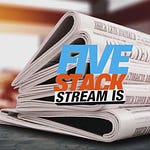Subscribe to
and by clicking on their names or sign up to Narativ.org and receive 25% off our annual subscription below.Traditional media is dying. Journalists are being laid off en masse. Trust in news is at historic lows, suppression has led to self-censorship. Are we witnessing the end of teh free press, or a rebirth. On tonight’s FiveStack, Substack co-founder Hamish McKenzie laid out a vision that could save journalism itself—and it's already working.
"This Has Absolutely Saved My Life"
Dean opened our exclusive interview with words you rarely hear directed at tech founders: "This is not another app. This is saving lives and families and free speech. It has absolutely saved my life."
He's not being dramatic. Both of us are living proof that Substack's model works. After years struggling in traditional media and social media platforms that rewarded sensationalism over substance, we found a platform that actually allows independent journalists to thrive. Dean gained 25,000 subscribers in two months. I've built a sustainable journalism business. But the numbers don't tell the whole story—it's about freedom.
From Tesla's Megaphone to Media's Revolution
Hamish's journey to building media's salvation began in an unlikely place: working for Elon Musk at Tesla. He reached out through the most unconventional networking strategy ever—emailing Elon's mom via her nutritionist website. It worked.
But Tesla taught him what not to build. "Elon really needs and wants to be the person who's effectively the editor of all of Tesla's communications," Hamish revealed. Instead of being an independent journalist inside the company, he became Tesla's voice—writing everything from blog posts to earnings reports.
This experience of being controlled, of having your editorial voice managed by a single powerful figure, directly influenced what Substack would become: the anti-Twitter, the anti-corporate media, the anti-everything that's wrong with today's information ecosystem.
The Death and Rebirth of Media
Hamish broke down media's evolution into three critical phases:
Phase 1: The Aristocracy (Traditional Media)
A few powerful institutions controlled all information flow through ownership of printing presses, broadcast towers, and distribution networks. Built on a 100+ year old business model that the internet destroyed.
Phase 2: The Oligarchy (Social Media Era)
"Everyone can have a voice," but power still flows to the top—Zuckerberg, Musk, the Chinese Communist Party. Writers dance for algorithmic peanuts while tech billionaires control the narrative.
Phase 3: The Democracy (The Substack Model)
True ownership for creators. Direct relationships with readers. Economic power distributed to independent voices. "It's not about hoarding power, but distributing power."
The Algorithm That Builds Trust Instead of Division
Here's what most people don't understand about Substack: it has algorithms, but they're designed for the opposite purpose of social media.
While Facebook and Twitter use algorithms to trap users in addictive doom-scrolling sessions to serve more ads, Substack's algorithms "are trying to drive people into deeper relationships." They help readers discover writers they might "fall in love with and learn to trust over time."
The result? As I've experienced firsthand, you don't see the irresponsible journalism that floods Twitter. There's "upward pressure on quality because you get paid from your audience and then you have to hold on to their loyalty over time."
The Network: The Future of News
The most exclusive part of our conversation revealed Substack's next evolution: the network model. Hamish envisions a system where independent journalists can collaborate formally while maintaining their independence—think traditional TV networks, but inverted.
Instead of powerful networks controlling local affiliates, independent creators choose to collaborate and share resources. "We're trying to build a network where you can grow, you can collaborate in new ways, you can cross-promote, you can share audiences."
This isn't just theory. Publications like The Free Press, Drop Site News, and The Ankler are already showing what's possible when journalists become media entrepreneurs, building teams while maintaining editorial independence.
The Economics of Trust
"Money is a crass thing to talk about," Hamish admitted, "but when it comes to journalism, it's very fucking important because it is the thing that funds the ongoing production of this really important work."
Substack's model is brutally simple: writers succeed by earning and keeping the trust of their audience over time. No corporate bosses. No advertiser pressure. No algorithmic gatekeeping. Just the ultimate compliment, as Dean put it: "having someone pay you for your time."
From Peanuts to Profits, From Chaos to Culture
"We've gone from an aristocracy to an oligarchy to something that's a lot more like democracy," Hamish explained. "It's exciting, a little bit messy in places, but overall a lot more free and can produce a lot more value."
The traditional media paid journalists peanuts while executives got rich. Social media gave writers followers, not income. Substack gives creators ownership—of their content, their audience, and their economic future.
How to Game the Algorithm
I couldn't resist asking Hamish the question every creator wants answered: "How do we game the algorithm?"
His response was beautifully simple: "All you have to do is keep producing quality work that your audience really values."
That's it. No hacks. No tricks. No chasing viral moments. Just good work, consistently delivered to people who want to read it.
The Ripple Effects of Doing the Right Thing
As Dean concluded our conversation: "Sometimes doing the right thing always works out for the people that want to do the right thing. The ripple effects of doing the right thing have created wealth, put food on tables for people, given people second, third, fourth lives in the media industry."
Substack didn't set out to save journalism—they set out to build a better system. But in creating a platform where writers can own their audience, control their content, and build sustainable businesses, they may have accidentally saved the news.
The New Economic Engine for Culture
After 30 minutes with Hamish, it's clear: Substack isn't just a newsletter platform. It's not just a Twitter alternative. It's a new economic engine for culture itself—one that rewards quality over quantity, relationships over reach, and truth over engagement.
The old media is dead. The social media oligarchy is crumbling under its own contradictions. What's rising in its place is something unprecedented: a truly democratic media ecosystem where good writers can make good livings doing good work.
And that, as Hamish would say, is how you save the news.
What part of Hamish's vision resonates most with you? Share your thoughts in the comments below.
















